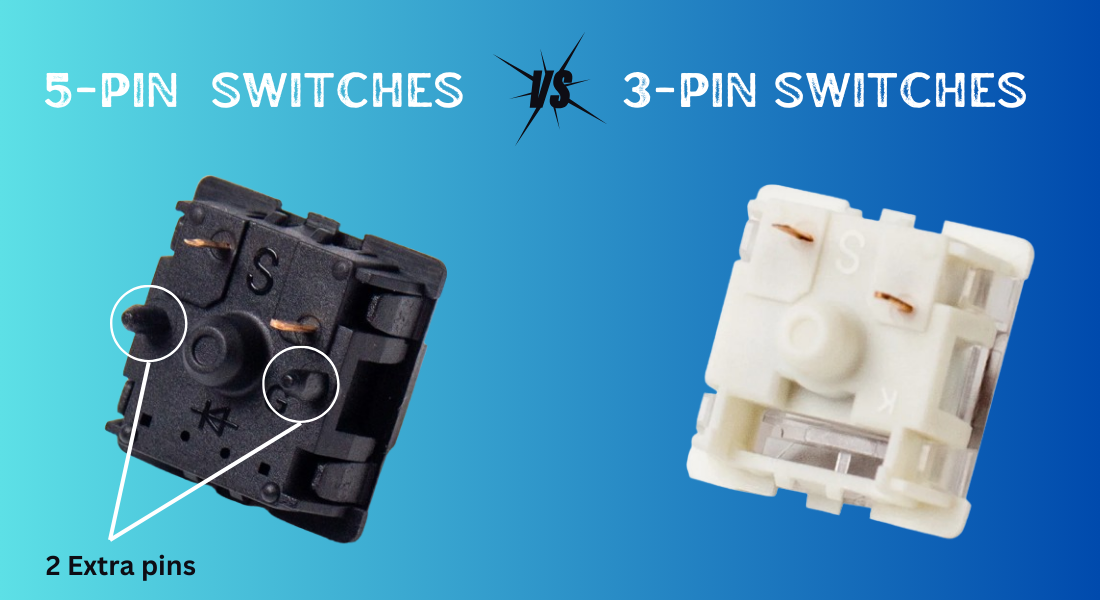When you're shopping for a new keyboard, you might come across terms like "5-pin" and "3-pin" keyboard switches. But what exactly do these terms mean, and how do they affect your typing experience? Let's delve into the difference between 5-pin (PCB-mounted switches) and 3-pin (plate-mounted switches) mechanical keyboard switches.
What Are 5-Pin Keyboard Switches?
5-pin switches, a newer variation, are also known as PCB-mounted switches. They have two additional plastic pins, known as PCB-mounted pins, in addition to the standard three pins. These extra pins are designed to provide additional stability and support when soldered directly onto the PCB. 5-pin mechanical keyboard switches are becoming increasingly popular in custom mechanical keyboards and are favored by enthusiasts for their added durability and reduced wobble.
One of the most popular 5-pin keyboard switches is the Cherry MX series, which has gained a reputation for its durability and smooth typing experience. These switches come in various colors, each offering a different tactile feel and actuation force, catering to different preferences and typing styles. Some common Cherry MX switch variants include Cherry MX Red, Cherry MX Blue, and Cherry MX Brown.
Pros of 5-Pin Keyboard Switches
1. Durability
Because of the extra pins, 5-pin switches are usually more durable and less prone to wobbling or loosening over time.
2. Better for Customization
If you're into customizing your keyboard, 5-pin switches might be a better choice. The extra pins make it easier to solder and desolder switches when modding your keyboard.
3. Stability
The additional pins enhance the stability of the switch, resulting in a more consistent typing experience.
Cons of 5-Pin Keyboard Switches
1. Limited Compatibility
Some keyboards may not support 5-pin switches, so you'll need to check compatibility before purchasing.
2. Slightly More Complex Installation
Installing 5-pin switches might be a bit more complex compared to 3-pin switches due to the extra pins.
What Are 3-Pin Keyboard Switches?
3-pin switches, also known as plate-mounted switches, are the traditional type of switches found in most mechanical keyboards. As the name suggests, they have three metal pins extending from the bottom, which are soldered onto the keyboard's printed circuit board (PCB). These switches are compatible with a wide range of keyboards and are relatively easier to find and replace. This design choice makes them easier to remove and replace compared to 5-pin switches, as they don't require desoldering from the PCB.
One notable example of 3-pin mechanical keyboard switches is the Kailh series, which offers a wide range of switch options similar to Cherry MX switches. Kailh switches are known for their affordability and compatibility with various keyboard designs, making them a popular choice among keyboard enthusiasts and manufacturers alike.
Pros of 3-Pin Keyboard Switches
1. Wide Compatibility
Most keyboards are designed to support 3-pin switches, making them a more versatile choice.
2. Easier Installation
With fewer pins, 3-pin switches are generally easier to install, especially for beginners who are new to keyboard modding.
3. Availability
Since 3-pin switches are more common, you'll have a wider range of options to choose from when shopping for keyboards or replacement switches.
Cons of 3-Pin Keyboard Switches
1. Less Stability
Compared to 5-pin switches, 3-pin switches may be slightly less stable, leading to a slightly less consistent typing experience.
2. Limited Customization Options
If you're into customizing your keyboard, you may find 3-pin switches less versatile compared to 5-pin switches.
Key differences between 5-pin and 3-pin keyboard switches:
Now that we've covered the pros and cons of both 5-pin and 3-pin mechanical keyboard switches, let's highlight some key differences between the two:
1. Mounting
The most apparent difference lies in how they are mounted onto the keyboard. 5-pin switches are soldered directly onto the PCB, providing extra stability, while 3-pin switches rely on the keyboard's plate for support, allowing for easier removal and replacement.
2. Stability
Due to their soldered connection, 5-pin switches tend to be more stable and less prone to wobbling during use. On the other hand, 3-pin switches may exhibit some wobbling, especially if the plate design is not sturdy enough.
3. Replacement
If a key switch needs replacement in a 5-pin keyboard, it requires desoldering and soldering a new switch onto the PCB, which can be time-consuming and requires some technical skill. In contrast, replacing a switch in a 3-pin keyboard is relatively simpler since it involves removing the keycap and popping in a new switch without soldering.
4. Compatibility
3-pin switches are generally more compatible with a variety of keyboard designs and layouts due to their simpler mounting mechanism. This makes them a preferred choice for custom keyboard builds and modifications.
5. Customization
Both 3-pin and 5-pin mechanical keyboard switches can be customized with different keycaps to alter the typing experience. However, 5-pin switches, with their added stability, may offer a more consistent feel when swapping keycaps. Enthusiasts often prefer 5-pin switches for custom builds due to their modifiability and compatibility with aftermarket parts such as switch swapping, stabilizers, and custom PCBs.
Which One Should You Choose?
The decision between 5-pin and 3-pin mechanical keyboard switches ultimately depends on your personal preferences and intended usage:
- For Stability and Customization: If you prioritize stability and plan to customize your keyboard extensively, 5-pin switches might be the better option for you.
- For Versatility and Ease of Replacement: If you value versatility and ease of replacement, or if you're unsure about committing to a specific keyboard layout, 3-pin switches could be the way to go.
Conclusion:
In conclusion, both 5-pin and 3-pin mechanical keyboard switches have their own set of advantages and considerations. If you prioritize ease of installation and wide compatibility, 3-pin switches may be the way to go. However, if you value stability, durability, and customization options, 5-pin switches could offer a better typing experience, especially for enthusiasts and custom keyboard builders.
Ultimately, the choice between 5-pin and 3-pin mechanical keyboard switches depends on your personal preferences, budget, and specific requirements. Whether you're a casual typist or a hardcore gamer, understanding these differences will help you make an informed decision when selecting your next mechanical keyboard or planning a custom build.
Experience premium mechanical keyboard switches from Keychron, offering both 5-pin and 3-pin keyboard switches. Explore a diverse selection featuring renowned brands like Cherry MX, Gateron, and Kailh. Elevate your typing experience with high-quality mechanical keyboard switches designed for durability and precision. Discover the best in mechanical keyboards with Keychron.

